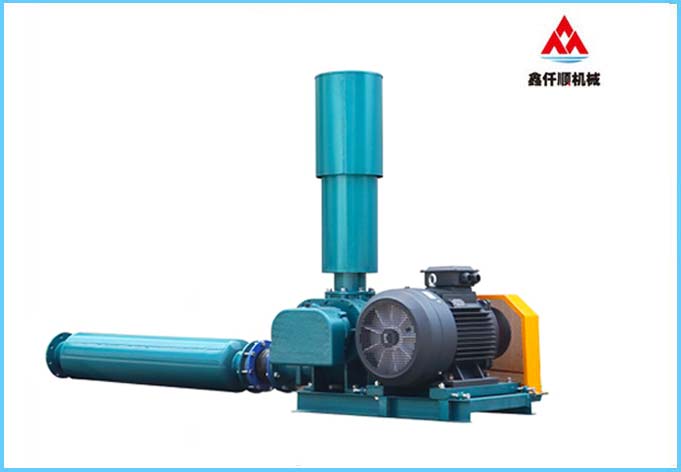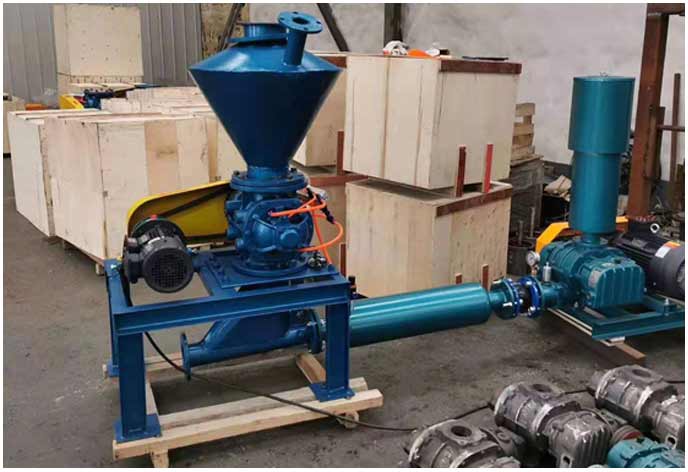What is the pressure of Roots blower? What is the difference from Roots vacuum pump?
According to the Xinqian Shun fan selection sample book, the maximum pressure of Roots blower can reach 200kpa, and it is difficult to achieve above this pressure.
The maximum negative pressure that can be achieved by the vacuum pump is - 79.9kpa, and it is difficult to achieve above this pressure.
Difference between Roots blower and Roots vacuum pump
Roots blower and Roots vacuum pump are both positive displacement fans. The structure principle and performance of the two are completely different.
Roots blower is positive pressure conveying, and roots vacuum pump is negative pressure suction air.
Roots blower is a constant torque high-pressure fan, which uses a pair of meshing gears for air suction and discharge. The exhaust pressure is much lower than that of the air compressor, which is not enough to drive the cylinder and pneumatic tools. It is often used in the aeration tank of the water treatment plant to inject high-pressure air into the pool for dust removal and gas discharge in coal mines, oxygen supply in fish ponds, smelting blast furnaces and other occasions where higher air pressure is required.

Roots blower has an exquisite structure, which is mainly composed of six parts: motor, air transition device, blower body, air chamber, base (also used as oil tank) and oil drip nozzle. The blower operates eccentrically by the rotor offset in the cylinder, and allows the volume change between the blades in the rotor slot to suck in, compress and discharge air. During operation, the pressure difference of the blower is used to automatically send lubrication to the oil drip nozzle, which drops into the cylinder to reduce friction and noise, and at the same time, it can keep the gas in the cylinder from backflow. Although it is small in size, it has large air volume, energy saving and silent operation, which is incomparable to other forms of fans.
The blower generally refers to the commonly used centrifugal fan, which belongs to the square torque load. Compared with the above two equipment, its exhaust pressure is very low, but its exhaust air volume is large for the same power. Roots blower is used for ventilation and heat exchange. The blower of the boiler, the induced draft fan, and the exhaust air of the heat exchange building in the tunnel furnace are also used for the powder concentrator of the stone powder factory, the chemical factory, the dye factory, and the flour factory, which are widely used.
Roots vacuum pump: ventilation process of Roots vacuum pump unit
Roots vacuum pump is widely used in metallurgy, petrochemical, paper making, food and electronics industries. In order to better use Roots vacuum pump and give full play to its high efficiency performance, Shandong Xinqianshun Machinery Co., Ltd. will explain its ventilation knowledge before use:
1. Air flows from the air inlet to Roots vacuum pump unit to form a convection blower. During this process, the doors and windows near the equipment remain closed, and the air is forced to flow into the workshop through the doors and windows on the side of the air inlet. The air is arranged orderly. It flows into the workshop from the air inlet, flows through the workshop, and then leaves the workshop.
2. Thorough and effective ventilation, with ventilation rate up to 99%. Through the specific engineering design, the ventilation speed and wind speed can be designed as required. Any high heat, harmful gas, dust and smoke can be quickly discharged from the workshop, and any problem of poor ventilation can be completely solved at one time, and can be solved within a few seconds after the workstation is opened.
3. Roots vacuum pump unit discharges air to the outside to reduce the indoor air pressure. The indoor air becomes thin. The characteristics of the water ring vacuum pump form a negative pressure area. Due to the compensation of pressure difference, the air flows into the room. In the practical application of industrial plants, it is installed centrally. On one side of the equipment, the air inlet is on the other side of the equipment.
The ventilation process of Roots vacuum pump unit can reduce the loss caused by resistance and improve efficiency.
Precautions for Roots vacuum pump operation:
1. Roots vacuum pump has uniform acoustic response during operation, and there is no noise and abnormal vibration during operation.
2. Pay attention to the motor load and the temperature rise of each part of the pump. Under normal conditions, the high temperature rise of the pump shall not exceed 40 ℃, and the working temperature shall not exceed 80 ℃.
3. If oil leakage is found during the work, please stop the work immediately and conduct inspection and maintenance after pressure relief. After oil leakage is found, Roots vacuum pump is not allowed to continue working or maintenance under pressure.
4. In the process of work, the normal inlet and outlet of cooling water must be ensured.
Preparations before starting Roots vacuum pump device:
1. Check whether the water level in the water tank of the flushing pump (front pump) exceeds 3/4 of the water tank, and if not, make up.
2. Check whether the water used in the water tank is clean. It is forbidden to use sewage containing silt to avoid blocking the pipeline. Roots vacuum pump increases the wear of pump impeller, increases the load of motor and leads to failure, thus affecting the service life of flushing pump.
3. Check the lubricating oil level in the intermediate pump and main pump. It must be greater than 3/4 of the oil window. At the same time, check the color of the lubricating oil. If there are many milky white or black impurities, please inform the technician to change the lubricating oil.
4. Check whether the circulating cooling water circuit of intermediate pump and main pump is intact, open the inlet and outlet valves of circulating cooling water, and check whether the inlet and outlet of circulating cooling water are normal.
5. Check whether the drain valve of buffer tank at the bottom of intermediate pump is closed.
6. Check whether the circuit of Roots vacuum pump is intact and whether the description of control cabinet is normal.
7. Check whether the starting pressure of the intermediate pump and the main pump of the contact pressure gauge of roots vacuum pump electrode is normal (the starting inlet pressure of the intermediate pump is above 0.065Mpa, and the starting inlet pressure of the main pump is above 0.065Mpa). Above 0.085Mpa).
8 After the above items are checked and confirmed to be correct, the roots vacuum pump can be started.
Roots vacuum pump: What data are usually required for the purchase of Roots vacuum pump as the basis for model selection?
The purpose can actually help us choose, especially those who have no parameters. If there are no specific parameters, the selection will be troublesome. Try to provide some other parameters, such as purpose. We can use our past experience to help us make choices.
2. Transmission medium
This is more important because if the inhaled medium is toxic gas or contains toxic gas, or contains strong corrosive gas, it has a very important impact on the selection.
3. Working environment
Since some areas are high altitude areas, such as Xinjiang and Tibet, it is necessary to provide working environment. When selecting these areas (such as coastal cities), the selection is different and varies greatly, so careful calculation is required.
4. Requirements for working conditions
The working condition requirements are: flow, pressure, temperature and other parameters are very important for selection. With these parameters, you can make a rough selection and position the model well.
5. Motor
Whether you need a motor or not will directly affect the price of the vacuum pump. If motor is required, please indicate in advance~ That's it Roots blower Do you understand the pressure and difference between Roots vacuum pump and Roots vacuum pump? I hope it can help you! Word tag: Roots blower










